Derren Brown's Blog, page 64
November 8, 2010
Robots Have Decided Humans Taste Like Bacon

"That robot in the picture is kinda' cute, isn't it? Just don't wave your hand around in front of its face like a small wounded animal.
Wired reports that some jackass built a robot that identifies human flesh as bacon. From their article titled "Let the robot holocaust commence: robots think we taste like bacon":
"Researchers at NEC System technologies and Mie University have designed the cute little guy to the right: a metal man gastronomist, "an electromechanical sommelier", capable of identifying wines, cheeses, meats and hors d'oeuvres. Upon being given a sample, he will speak up in a childlike voice and identify what he has just been fed. The idea is that wineries can tell if a wine is authentic without even opening the bottle, amongst other more obscure uses…like "tell me what this strange grayish lump at the back of my freezer is/was."
But when some smart aleck reporter placed his hand in the robot's omnivorous clanking jaw, he was identified as bacon. A cameraman then tried and was identified as prosciutto.""
Read more at Dateline Zero (Thanks Johnny5)
Scientists Look to Recreate Big Bang
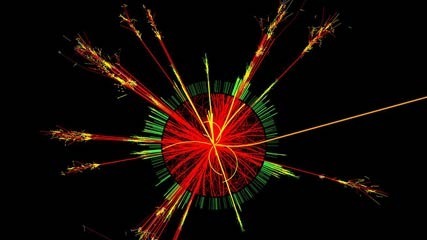
"Talk about a trip back in time. Scientists have always wondered what it was like at the moment of and immediately after the creation of the universe, generally known as the Big Bang. Soon, they may find out.
By using the world's biggest and most powerful particle accelerator — the Large Hadron Collider, or LHC — researchers will attempt to create, essentially, mini-Big Bangs that will help them study matter that once existed almost 14 billion years ago.
OK, if this all sounds a bit heady — especially for those of us who wonder how we're going to get by until the next paycheck comes around — let's break this down a bit.
First — and we might as well start at the beginning — the Big Bang theory (apart from being a very funny TV sitcom) suggests that the universe was created 13.7 billion years ago when extremely high energy caused a rapid expansion of what is theorized was a very hot and dense state, and it continues to expand outward.
The LHC was built by the European Organization for Nuclear Research, or CERN at its laboratory near the French-Swiss border.
The machine sits in a 17-mile-in-circumference underground tunnel near Geneva and is used to study what the known universe is made of and why it works the way it does. Fundamental particles are made to collide inside the accelerators, and this helps scientists understand more about the laws of nature.
Researchers hope that by colliding lead ions inside the huge LHC "Big Bang machine," they'll be able to recreate what the young universe looked like."
Read more at AOL News (Thanks @XxLadyClaireXx)
November 7, 2010
Fish species stay alive on land with special skin
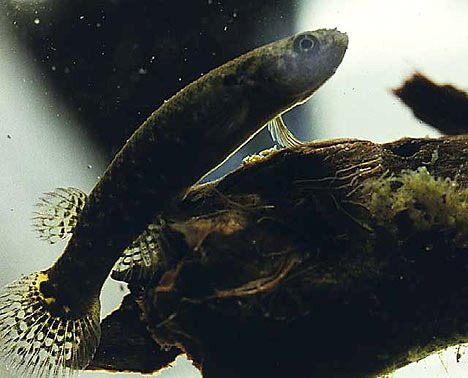
"A new study shows how an amphibious fish stays alive for up to two months on land. It's all in the skin. Mangrove killifish are small fish, only about an inch or two long, that live in temporary pools in the coastal mangrove forests of Central and South America and Florida. During dry seasons when their pools disappear, the fish hole up in leaf litter or hollow logs. As long as they stay moist, they can survive for extended periods out of water by breathing air through their skin. But oxygen isn't the only thing a fish out of water needs to worry about, according to Professor Patricia Wright, a biologist from the University of Guelph, Ontario, who has studied these fish for years. "All cells in the body need the right combination of ions and water for an animal to stay alive," Wright explains. "Normally, the gills are responsible for these processes in fish. We knew that in mangrove killifish the gills are likely useless on land, so how these fish maintain ion balance out of water was a mystery."
Wright's latest research, published in the November/December 2010 issue of the journal Physiological and Biochemical Zoology, shows that the skin of the mangrove killifish picks up the slack for the gills. Through a series of laboratory experiments, Wright and her team found special cells called ionocytes clustered on the skin of the fish. Ionocytes, normally found on the gills of other fish, are the cells responsible for maintaining the right balance of water and salt in a fish's cells. "We found the mangrove killifish have roughly as many ionocytes on their skin as on their gills," Wright said. Other fish species have skin ionocytes in larval stages of development, but usually these cells disappear in the skin as the fish develops."
Read more at Physorg (Thanks @moonylein)
Chatbot Debates Climate Change Deniers on Twitter so You Don't Have to
"Sick of chasing down climate denialists himself, Nigel Leck put his programming skills to use for him. He created the Twitter bot @AI_AGW, who also goes by the name "Turing Test." Every five minutes the bot searches Twitter for tweets relating to climate change denialism, and automatically responds to the posters using a database of hundreds of rebuttals, which include links to information and videos. Christopher Mims at Technology Review talked to Leck about the project: "The database began as a simple collection of responses written by Leck himself, but these days quite a few of the rejoinders are culled from a university source whom Leck says he isn't at liberty to divulge."
Some of @AI_AGW's debates have gone on for hours or days, with the recipient not knowing they are talking to a bot, even though its handle says AI and it includes a link to the Wikipedia page on the Turing test. The program is smart enough to run through a list of responses, which is especially helpful when debating with people who keep throwing the same arguments at you time after time.
Leck has seen all different kinds of responses to the bot, but most fall into two categories, he told Mims:
"If [the chatbot] actually argues them into a corner, it tends to be two crowds out there," says Leck. "There's the guns and God crowd, and their parting shot will be 'God created it that way' or something like that. I don't know how you answer that." The second crowd, Leck says, are skeptics so unyielding they won't be swayed by any amount of argumentation."
Read more at Discover Magazine (Thanks @powerofstrange)
November 6, 2010
Air Force Wants Neuroweapons to Overwhelm Enemy Minds

"It sounds like something a wild-eyed basement-dweller would come up with, after he complained about the fit of his tinfoil hat. But military bureaucrats really are asking scientists to help them "degrade enemy performance" by attacking the brain's "chemical pathway[s]." Let the conspiracy theories begin.
Late last month, the Air Force Research Laboratory's 711th Human Performance Wing revamped a call for research proposals examining "Advances in Bioscience for Airmen Performance." It's a six-year, $49 million effort to deploy extreme neuroscience and biotechnology in the service of warfare.
One suggested research thrust is to use "external stimulant technology to enable the airman to maintain focus on aerospace tasks and to receive and process greater amounts of operationally relevant information." (Something other than modafinil, I guess.) Another asks scientists to look into "fus[ing] multiple human sensing modalities" to develop the "capability for Special Operations Forces to rapidly identify human-borne threats." No, this is not a page from The Men Who Stare at Goats.
But perhaps the oddest, and most disturbing, of the program's many suggested directions is the one that notes: "Conversely, the chemical pathway area could include methods to degrade enemy performance and artificially overwhelm enemy cognitive capabilities." That's right: the Air Force wants a way to fry foes' minds — or at least make 'em a little dumber."
Read more at Wired (Thanks Chris)
The Fascinating Story of the Twins Who Share Brains, Thoughts, and Senses
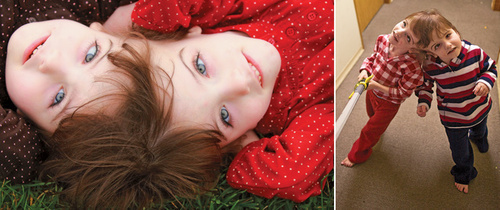
"This is one of the most surprising and awesome tales ever told in the history of medicine. These twins are Tatiana and Krista Hogan. Their brains and sensory systems are networked together, but they have separate personalities. Their story defies belief.
So much, in fact, that Tatiana and Krista Hogan shouldn't be alive at all. Their chances of surviving the pregnancy, birth and first months of life were almost zero. Surprisingly, they turned four on October 25, and they are still healthy and happy, as you can see in the photo above.
They play Nintendo Wii games against each other, they fight for toys and they share food and physiological functions. But they also share their senses. For example, one can pick an object out of her field of view, while the twin looks at the object.
Most importantly, however, they can share each other thoughts, like their grandmother—Louise McKay—describes:
"They share thoughts, too. Nobody will be saying anything, and Tati will just pipe up and say, 'Stop that!' And she'll smack her sister."
Scientists are nothing short of absolutely amazed. Here you have two kids, completely different from each other, with their own distinct personality, but with connected brains and sensory systems. Dr. Douglas Cochrane—neurosurgeon at Vancouver's Children's Hospital—has tested their networking abilities:
"Their brains are recording signals from the other twin's visual field. One might be seeing what the other one is seeing.""
Read more at Gizmodo
Scenes of thought: The brain in pictures
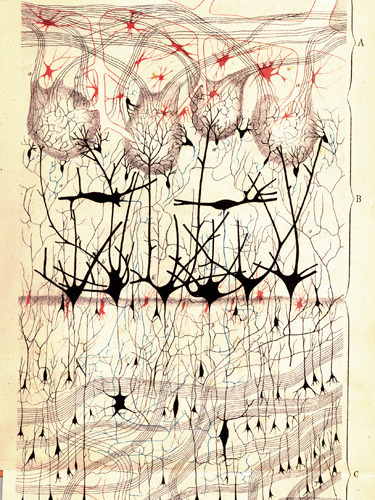
"What does your mind look like? A new book, Portraits of the Mind by Carl Schoonover, looks at how scientists have visualised the brain through the centuries."
Above: "Olfactory bulb
In 1875 the physician Camillo Golgi invented the reazione nera (black reaction) cell-staining technique, which allowed anatomists to view individual neurons in their entirety for the first time. Potassium dichromate and silver nitrate are added to preserved nervous tissue, and the neurons become visible as tiny silver chromate crystals form inside the cells.
Golgi used the technique to make detailed neuronal maps, such as this drawing of a dog's olfactory bulb, made in the year he discovered the reaction. The technique became widely known as "Golgi's method" and marks the beginning of modern neuroscience. "
See more at New Scientist (Thanks @nettmac)
November 5, 2010
10 Commonly Believed Myths about the Human Body
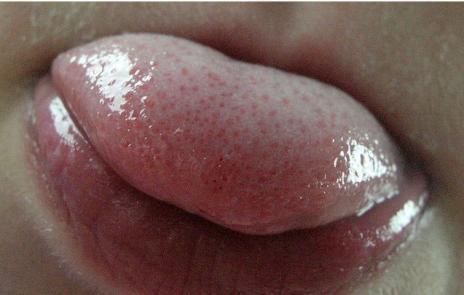
"We have learned much about our bodies through old wives' tales handed down from our moms and grandmothers and even in school, but not all of it is correct. Here we look at 10 misconceptions that might surprise you.
10. Sleepwalkers should never be woken
Sleepwalkers are often confused and/or disoriented when awakened but this is far better than the danger of injuries that are common from tripping over things, walking into dangerous areas and more. Thus, wake them gently and help them get back to bed.
9. You will catch a cold if you go out in wet, freezing weather
There is no evidence to support this misconception at all. Viruses are more common in the low humidity time of winter and of course, people are gathered indoors more, so they spread easily but the only thing that going out in the cold does is perhaps lower your resistance to an infection you already have, starting some temporary sneezing and coughing.
8. Fingernails and hair continue to grow after death
Neither continue to to grow. What does happen is that the cuticles and skin shrink after death, making it appear as if the nails and hair were lengthening."
Read the rest at Environmental Graffiti (Thanks Christopher C)
Implanted chip 'allows blind people to detect objects'
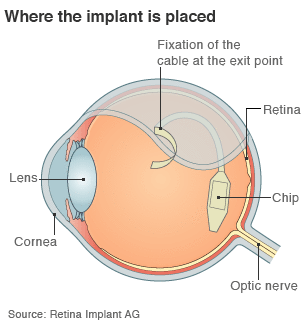
"A man with an inherited form of blindness has been able to identify letters and a clock face using a pioneering implant, researchers say. Miikka Terho, 46, from Finland, was fitted with an experimental chip behind his retina in Germany. Success was also reported in other patients. The chip allows a patient to detect objects with their eyes, unlike a rival approach that uses an external camera. Details of the work are in the journal Proceedings of the Royal Society B.
Professor Eberhart Zrenner, of Germany's University of Tuebingen, and colleagues at private company Retina Implant AG initially tested their sub-retinal chip on 11 people. Some noticed no improvement as their condition was too advanced to benefit from the implant, but a majority were able to pick out bright objects, Prof Zrenner told the BBC. However, it was only when the chip was placed further behind the retina, in the central macular area in three people, that they achieved the best results."
Read more at BBC News (Thanks @XxLadyClaireXx)
November 4, 2010
TV tonight
On BBC4 tonight at 9 there is a programme about self-portraits. Featured in it is my dear friend Patrick Hughes, who creates astounding reverse-perspective paintings/sculptures that appear to move with you as you walk around the room. I have a few of his pieces at home and it is delightful watching visitors unable to fathom what they are experiencing. He has recently cast my little head for a 'reverspective' portrait, and has also done one of himself, which will appear in the BBC4 show. Mine, I hear, is ready too, and I'm picking it up from him tomorrow. We've in fact done a portrait swap: I am painting him in return for his portrait of me. I'll feature both on this blog – including the pictures of me getting my head cast – when I have everything ready to show you. He is the most richly wonderful man, and a unique artist, so do catch the show tonight if you can to get a heads-up (pun intended) on this guy.
Derren Brown's Blog
- Derren Brown's profile
- 797 followers



